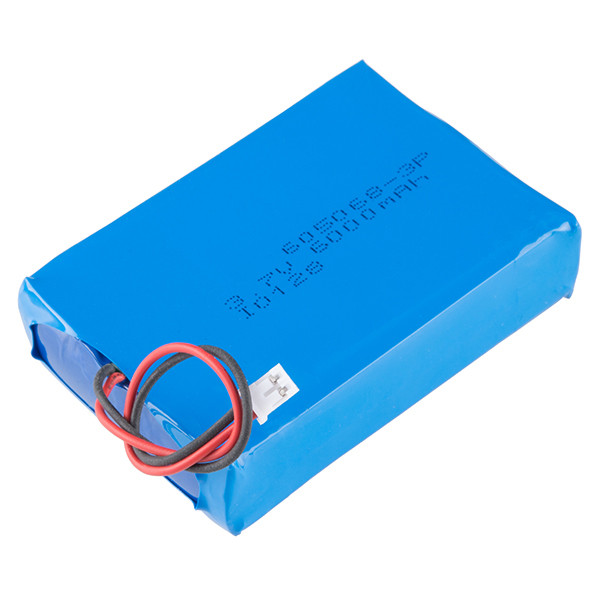Introduction
In today’s highly technological world, polymer lithium – ion batteries have become an integral part of our daily lives. They power a wide range of devices, from our smartphones that keep us connected at all times, to the laptops we use for work and entertainment, and even the electric vehicles that are revolutionizing transportation. These batteries are favored for their high energy density, lightweight design, and relatively long lifespan. However, not all polymer lithium – ion batteries are the same. One of the key differentiators is their voltage, with common voltages including 3.6V, 3.7V, 3.8V, and 3.85V. Each of these voltage levels has its own unique characteristics, advantages, and ideal applications. Understanding these differences is crucial whether you are a consumer looking to choose the right device, an engineer designing a new product, or a business owner in the electronics industry. So, let’s dive deep into the world of polymer lithium – ion batteries and explore the distinctions between these different voltage types.
1. Basics of Polymer Lithium – Ion Batteries
1.1 Working Principle
Polymer lithium-ion batteries operate based on the movement of lithium ions between the positive and negative electrodes. The positive electrode, also known as the cathode, is typically made of a lithium-containing compound such as lithium cobalt oxide (LiCoO2), lithium nickel oxide (LiNiO2), or lithium manganese oxide (LiMn2O4). The negative electrode, or anode, is usually composed of graphite. The electrolyte, a key component in the battery, is a polymer material that contains lithium salts.During the charging process, an external power source is connected to the battery. This causes the lithium ions in the cathode to be oxidized, releasing electrons. The lithium ions then move through the polymer electrolyte towards the anode, while the electrons flow through the external circuit from the cathode to the anode. At the anode, the lithium ions are reduced and inserted into the graphite structure. This process stores energy in the battery. Mathematically, the reaction at the cathode during charging can be represented as: LiCoO2 → Li1-xCoO2+xLi^+ +xe^-) (where x represents the degree of lithium extraction). And at the anode: xLi^++xe^- + 6C →LixC6.When the battery is discharging, the process is reversed. The lithium ions in the anode are oxidized and move back through the electrolyte to the cathode. The electrons flow through the external circuit from the anode to the cathode, providing electrical energy to power the connected device. The overall discharge reaction for a lithium – ion battery with a lithium – cobalt – oxide cathode and a graphite anode is Li_xC6+Li_{1 – x}CoO2→LiCoO2 + 6C. This movement of lithium ions between the electrodes, often referred to as the “rocking-chair” mechanism, allows the polymer lithium-ion battery to charge and discharge repeatedly.
1.2 General Advantages
- High Energy Density: Polymer lithium-ion batteries have a significantly higher energy density compared to many other types of batteries, such as nickel – cadmium Ni – Cd and nickel-metal-hydride (Ni-MH) batteries. This means that for a given weight or volume, they can store more electrical energy. For example, a polymer lithium – ion battery can store approximately 2 – 3 times more energy per unit weight than a (Ni – Cd) battery. This high energy density makes them ideal for portable electronic devices where minimizing weight and size while maximizing power storage is crucial, like smartphones and tablets.
- Lightweight: Since they don’t require a heavy metal casing like some traditional batteries, polymer lithium – ion batteries are relatively lightweight. In fact, they can be up to 40% lighter than steel-cased lithium – ion batteries of the same capacity. This weight reduction not only makes the devices they power more portable but also has implications for applications in electric vehicles, drones, and aerospace, where every gram of weight reduction can improve performance and efficiency.
- Shape Customizability: One of the unique features of polymer lithium-ion batteries is their ability to be manufactured in various shapes and sizes. Unlike cylindrical or prismatic batteries with fixed forms, polymer lithium-ion batteries can be made in thin, flat, or even curved shapes. This allows for more flexible design in electronic devices. For instance, in some ultra-thin laptops or wearable devices, the battery can be shaped to fit precisely within the available space, optimizing the overall design and functionality of the product.
- Safety: The use of a polymer electrolyte instead of a liquid electrolyte in these batteries enhances their safety. In case of a malfunction or damage, liquid – electrolyte batteries are at risk of electrolyte leakage, which can be flammable or corrosive. Polymer lithium – ion batteries, on the other hand, are less likely to experience such leakage. Additionally, they are more resistant to internal short circuits due to their construction and the properties of the polymer materials used. Even in extreme conditions, a polymer lithium-ion battery is more likely to experience a less – severe failure mode, such as swelling, rather than an explosion as seen in some traditional battery types.
2. The Significance of Voltage in Batteries
Voltage in batteries is a fundamental parameter that plays a pivotal role in determining their performance and the scope of their applications. It can be thought of as the “driving force” that pushes electrons through an electrical circuit, much like water pressure in a plumbing system.
2.1 Power Output
The voltage of a battery directly impacts its power output. According to the formula (P = VI) (where (P) is power in watts, (V) is voltage in volts, and (I) is current in amperes), for a given current, a higher – voltage battery will deliver more power. In high – power – demanding applications such as electric vehicles, a high – voltage battery system is essential. For example, the battery systems in many electric cars operate at several hundred volts. This high voltage enables the vehicle to achieve quick acceleration and high – speed driving. In contrast, a low – voltage battery would struggle to provide the necessary power to move the vehicle efficiently. In the case of a small electric scooter powered by a 48V battery, it can reach a certain top speed and carry a limited load. If the voltage were reduced to, say, 36V, the scooter’s performance would be severely degraded, with slower acceleration and a lower top speed.
2.2 Compatibility with Electronic Devices
Each electronic device is designed to operate within a specific voltage range. A smartphone, for instance, is engineered to work optimally with a battery voltage that is typically around 3.7V or 3.8V. Using a battery with a significantly different voltage can lead to malfunctions or even damage to the device. If a 3.6V battery is used in a device designed for 3.8V, the device may not function properly, as the lower voltage may not be sufficient to power all the components. On the other hand, using a battery with a voltage that is too high can over – stress the components, causing overheating, component failure, or in extreme cases, a fire hazard. For example, connecting a 5V power source to a 3.7V – rated smartphone battery charger circuit can damage the charger’s components and potentially the battery itself.
2.3 Energy Storage and Discharge Characteristics
Voltage is also related to the energy storage capacity of a battery. A higher – voltage battery can store more energy per unit mass or volume, assuming the same chemistry and design principles. During the discharge process, the voltage of a battery gradually decreases as the stored chemical energy is converted into electrical energy. Understanding the voltage – discharge curve is crucial for predicting the remaining battery life and the performance of the device over time. For example, in a laptop battery, as the voltage drops during use, the laptop’s performance may start to degrade, with slower processing speeds and reduced brightness on the screen. Different voltage – rated polymer lithium – ion batteries have unique discharge curves, which can impact how long a device can operate before needing to be recharged.
3. In – Depth Analysis of 3.6V, 3.7V, 3.8V, and 3.85V Batteries
3.1 3.6V Polymer Lithium – Ion Batteries
3.6V polymer lithium – ion batteries were more common in the earlier days of portable electronics. They have a relatively lower energy density compared to some of the higher – voltage counterparts. For example, in early – generation mobile phones and MP3 players, 3.6V batteries were frequently used. The energy density of these batteries is typically around 100 – 150 Wh/kg.In terms of discharge characteristics, they have a relatively stable discharge voltage within a certain range. When discharging, the voltage gradually drops from around 4.0V (fully charged) to about 2.5 – 2.7V when almost depleted. This relatively stable discharge voltage makes them suitable for devices that do not require extremely high – power output and can operate within a relatively narrow voltage range.One of the reasons for their popularity in the past was their simplicity in design and manufacturing. They were easier to produce at a lower cost, which made them accessible for mass – produced consumer electronics. However, as technology advanced and the demand for longer – lasting and more powerful batteries grew, their usage has gradually declined in many mainstream applications.
3.2 3.7V Polymer Lithium – Ion Batteries
3.7V polymer lithium – ion batteries have become the de facto standard in the consumer electronics market. They offer a good balance between energy density, cost, and overall performance. The energy density of 3.7V batteries can range from 150 – 200 Wh/kg, which is higher than that of 3.6V batteries. This higher energy density allows them to store more energy in the same volume or weight, providing longer – lasting power for devices.In smartphones, for instance, a 3.7V battery can power the device for a full day of normal usage, including activities such as making calls, sending messages, browsing the web, and running various applications. Their wide – spread use is also due to their compatibility with a vast range of electronic components and circuits. Most electronic devices are designed with components that can operate optimally within the voltage range provided by a 3.7V battery, which simplifies the design process for manufacturers.Tablets also benefit from 3.7V batteries. They can support hours of video playback, gaming, and other resource – intensive tasks. Additionally, the charging infrastructure for 3.7V batteries is well – established. Standard chargers are readily available, and the charging technology has been optimized over the years to ensure safe and efficient charging.
3.3 3.8V Polymer Lithium – Ion Batteries
3.8V polymer lithium – ion batteries represent an upgrade in performance compared to 3.7V batteries. They offer a higher energy density, typically in the range of 200 – 250 Wh/kg. This increase in energy density means that for the same physical size or weight, a 3.8V battery can store more energy, providing longer operation times for devices.In high – end drones, a 3.8V battery can significantly extend the flight time. Drones are power – hungry devices, and the extra energy provided by a 3.8V battery allows them to stay in the air for a longer period, which is crucial for applications such as aerial photography, surveying, and delivery services. Professional cameras also benefit from 3.8V batteries. These cameras often require a stable and high – power energy source to operate features like continuous autofocus, high – speed shooting, and power – hungry image – processing algorithms. A 3.8V battery can ensure that the camera functions smoothly even during extended shooting sessions.Another advantage of 3.8V batteries is their longer lifespan in some cases. Due to their improved chemical composition and construction, they can withstand more charge – discharge cycles before their performance starts to degrade significantly. This makes them a more cost – effective choice in the long run for devices that are used frequently and require reliable battery performance over time.
3.4 3.85V Polymer Lithium – Ion Batteries
3.85V polymer lithium – ion batteries are relatively new to the market and are being explored for their potential in emerging technology fields. They have a high – energy – density potential, with some estimates suggesting they could reach 250 – 300 Wh/kg or even higher. This high energy density makes them very promising for use in new – generation electric vehicles.In electric vehicles, a higher – voltage battery like the 3.85V polymer lithium – ion battery can potentially increase the vehicle’s range. With more energy stored in the battery, the vehicle can travel further on a single charge, which is a major concern for consumers when considering electric vehicles. Additionally, these batteries can support faster charging rates. As the demand for quick – charging solutions in the electric vehicle market grows, 3.85V batteries may be able to meet this need more effectively than lower – voltage batteries.In high – performance energy – storage systems, such as those used in smart grids or large – scale renewable energy installations, 3.85V batteries can play a crucial role. They can store large amounts of energy efficiently and release it when needed, helping to balance the power supply and demand on the grid. Their high – voltage and high – energy – density characteristics make them suitable for handling the large – scale energy fluctuations associated with renewable energy sources like solar and wind power. Although still in the early stages of widespread adoption, 3.85V polymer lithium – ion batteries have the potential to revolutionize these emerging technology areas as the technology continues to mature and costs are reduced.
4. How to Choose the Right Voltage Battery
4.1 Consider Your Device’s Requirements
When choosing a polymer lithium – ion battery, the first and foremost factor to consider is the requirements of the device it will power. Check the device’s user manual or technical specifications to determine the recommended battery voltage. For example, if you are replacing the battery in an older – model smartphone, it may be designed to work with a 3.7V battery. Using a battery with a different voltage, such as a 3.8V battery, could potentially damage the device’s charging circuit or other components.The power consumption of the device also plays a crucial role. High – power – consuming devices, like high – end gaming laptops or professional – grade cameras, may require a battery with a higher voltage to ensure stable and continuous operation. If a device has multiple components that draw a significant amount of power simultaneously, a higher – voltage battery can provide the necessary electrical “push” to keep everything running smoothly. Additionally, consider the device’s usage frequency. If you use a device frequently throughout the day, you might want to choose a battery with a higher energy density, which is often associated with higher – voltage batteries, to reduce the need for frequent recharging.
4.2 Future – Proofing Your Choice
As technology continues to advance at a rapid pace, it’s important to consider the future when choosing a battery. While your current device may be compatible with a specific voltage battery, future upgrades or new devices you plan to purchase may have different requirements. For instance, if you are in the market for a battery for a drone, and you anticipate that in the next few years, you may want to upgrade to a more advanced model with additional features and higher power demands, it might be wise to choose a 3.8V or even a 3.85V battery now. This way, you can be better prepared for the future and avoid having to replace the battery again when you upgrade your device.Moreover, industries are constantly evolving, and new standards and technologies may emerge. By choosing a battery with a relatively higher voltage that is becoming more prevalent in emerging technologies, such as 3.85V batteries in the electric vehicle and high – performance energy – storage sectors, you are making a more future – proof choice. This not only ensures compatibility with potential future devices but also gives you access to the latest advancements in battery technology, such as higher energy densities and faster charging capabilities. However, it’s also important to balance this future – proofing strategy with the current needs of your device and your budget, as higher – voltage and more advanced batteries may come at a higher cost.
5. Conclusion
In conclusion, the differences between 3.6V, 3.7V, 3.8V, and 3.85V polymer lithium – ion batteries are significant and directly impact their performance and applications. 3.6V batteries, although less common today, were once a staple in early – generation portable electronics due to their simplicity and cost – effectiveness. However, their relatively low energy density has made them less popular as technology has advanced.3.7V batteries have become the standard in the consumer electronics market, powering a wide range of devices from smartphones to tablets. They offer a good balance of energy density, cost, and compatibility, making them a reliable choice for everyday devices.3.8V batteries represent an upgrade in performance, with higher energy densities and longer lifespans in some cases. They are ideal for high – power – demanding devices such as drones and professional cameras, where their enhanced capabilities can significantly improve device performance.3.85V batteries, while still in the early stages of widespread adoption, hold great promise for emerging technology fields such as electric vehicles and high – performance energy – storage systems. Their high – energy – density potential and ability to support faster charging rates could revolutionize these industries.When choosing a polymer lithium – ion battery, it is crucial to carefully consider the requirements of your device and future – proof your choice as much as possible. Whether you are a consumer, an engineer, or a business in the electronics industry, making an informed decision about the right voltage battery can ensure optimal device performance, longevity, and cost – effectiveness. Don’t hesitate to reach out to our team of experts if you have any further questions or need assistance in selecting the perfect polymer lithium – ion battery for your specific needs.





